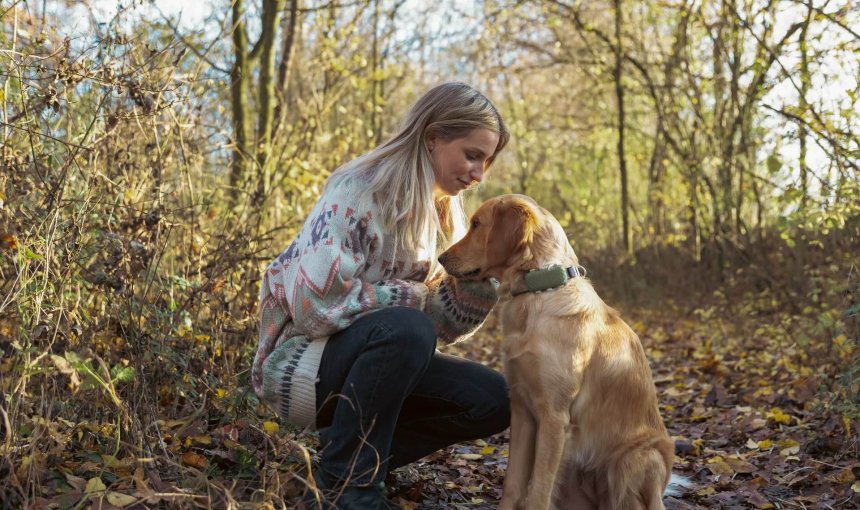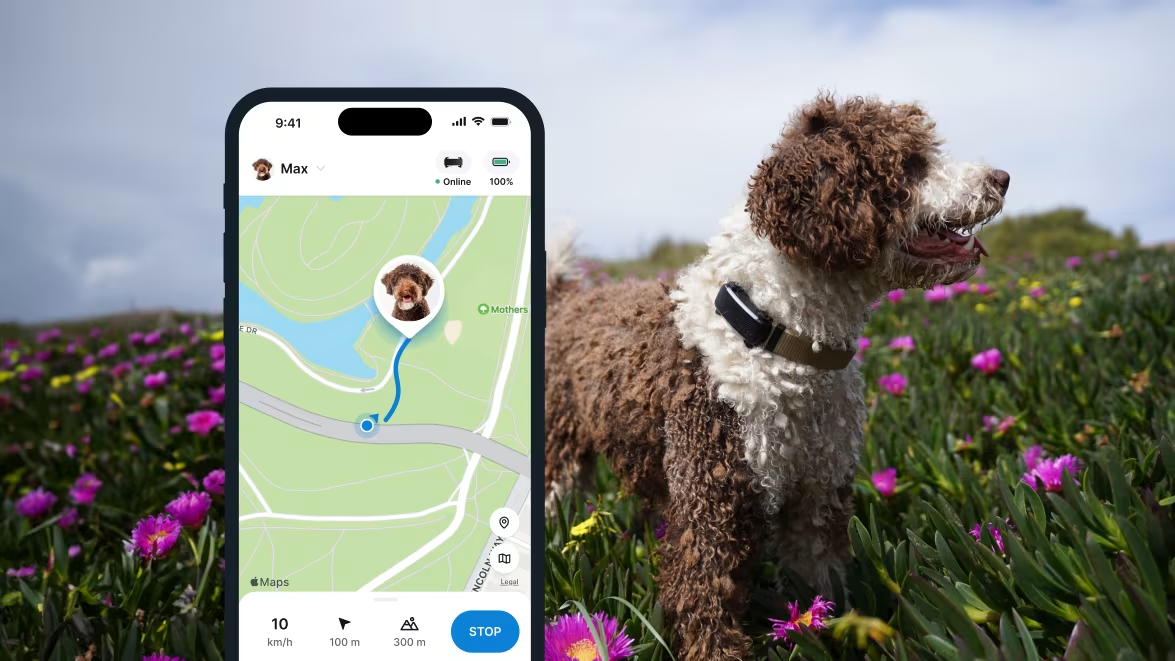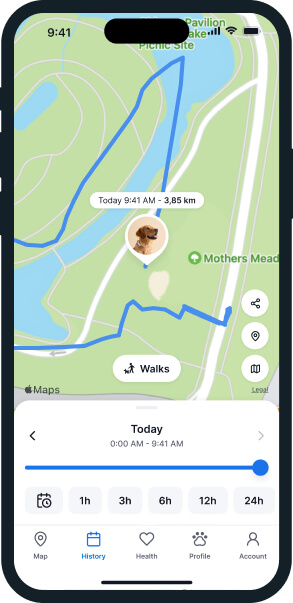How To Find A Lost Dog And Bring Them Home Fast
If your dog is missing right now, don't panic - instead, act. Read our tips and tricks for bringing your dog home successfully.

Losing your dog is a heart-wrenching experience – but you’re not powerless. Whether they bolted through an open gate or wandered off during a walk, acting quickly and strategically can make all the difference. In this guide, we’ll walk you through our best tips on how to find a lost dog fast – plus share the #1 way to make sure you never lose your dog again.
Key Takeaways
- If your dog is lost, stay calm and act quickly – your response matters.
- Start by searching your surroundings and calling their name; bring something that smells like home.
- Notify neighbors, shelters, and vets, and post on local social media groups and lost pet platforms.
- Prevent future escapes by securing your space and using tools like a smart dog tracker.

Always know your buddy is healthy & safe
Read more- Key Takeaways
- What are the chances of finding a lost dog?
- How to find a lost dog
- 1) Check at home first
- 2) Call & verify your lost dog’s microchip contact information
- 3. Determine your search radius
- 4. Search the area where your dog was lost
- 5. Report your dog missing
- 6. Use Facebook & other social media networks
- 7. Make & distribute lost dog posters
- 8. Consider other options to find a lost dog
- 9. Don’t give up!
- How to find a lost dog with a Tractive GPS Dog Tracker
- Final thoughts on how to find a lost dog
What are the chances of finding a lost dog?
Below, you’ll find out how to find a lost dog. But first, here are some encouraging lost dog facts to reassure you. A 2012 ASPCA study on lost pets found that:
- 93% of lost dogs were eventually recovered
- 90% is the likelihood of finding a lost dog within the first 12 hours
- 49% of dog parents found their canine friend by searching the neighborhood
- 16% of lost dogs manage to find their way back home
- 15% of dog parents found their dogs thanks to a microchip or ID tag
- 6% of dog parents found their dogs at animal shelters
- A lost dog can potentially survive months or even years on their own
So if you have a lost dog, start your search right away to boost your chances of finding them. Your dog might even return on their own, using scent to guide their way. Even the most domesticated dogs can travel long distances and survive by scavenging for food and water until they are home again.
The #1 way to prevent your dog getting lost
Want to stop the panic before it starts? The best way to prevent your dog from going missing – and make sure you can find them fast if they do – is by using a GPS tracker made for dogs.
With the Tractive GPS & Health Tracker for dogs, you’ll always know where your pup is, no matter how far they roam. It shows your dog’s real-time location on your phone, so you can track them down immediately. Set up a Virtual Fence and you’ll get an alert the moment they leave your safe zone – even before you realize they’re gone.

Why it works:
- LIVE tracking shows your dog’s location every few seconds
- Location History helps you spot where they usually go
- Escape Alerts let you know the second they leave your yard or neighborhood
🐾 Many dog parents have found their adventurous pups within minutes, thanks to Tractive. Read how Tractive even helped save these dogs’ lives.
Don’t wait for your dog to go missing – stay one step ahead.
How to find a lost dog
1) Check at home first
If your dog is missing, first check your home and your immediate surroundings. Do you have a scared dog? If so, they may be hiding nearby. Otherwise, it’s possible your buddy could’ve gotten stuck somewhere. Make sure to check inside the:
- Closets
- Shed/garage
- Pool
- Cars
- Basement/attic
- Under the deck
- Garden
- and anywhere else your four-legged friend might be in the habit of hanging out in.
Ask your friends or family to help you search. Bring your dog’s favorite treats or toy with you to lure them out of hiding. Place your dirty clothes or your dog’s bedding outside to attract your dog using a familiar scent.
2) Call & verify your lost dog’s microchip contact information
If your lost dog has been microchipped, call the microchip company to make sure your contact info is up to date. Let your microchip company know that your dog is missing so they can alert local animal shelters.
- If you know the microchip ID number but not the company, use the universal pet microchip lookup.
- You can also register your contact details in microchip databases such as the Free Pet Chip Registry (911PetChip) or Pet Link
⚠️ Just remember: only 15% of lost dog parents found their dog thanks to a microchip or ID tag. Meaning, you can’t rely on a microchip alone to find your dog. Microchips do not contain any GPS or other technology that would help you track or locate your dog in real time. Its only job is to identify a missing dog’s details in case they are lost and found.
Read more: Microchip vs GPS Dog Tracker: Debunking The Myth Of The Dog Tracker Chip
3. Determine your search radius
Next, before you expand your search for your lost dog, ask yourself these questions to help narrow down your search radius:
- Did your dog go missing near home, or in an unfamiliar area?
- Was your dog frightened away by something, or looking for an adventure?
- Are there places or people nearby you know your dog may have gone to visit?
- Are there dangers nearby, places where your pet could get stuck or in trouble?
- How far do you realistically think your dog could have traveled in the amount of time they’ve been lost?
- Is your dog active and fit and likely to have run further, or laid-back and less active?
- How long has your dog been missing?
⚠️ Be careful not to jump to conclusions which may cause you to give up your search. For example, don’t assume your dog was kidnapped or attacked. It could very well be they got distracted by a wild animal, or are stuck in a neighbor’s fence down the road.
4. Search the area where your dog was lost
If your dog has not returned to you yet, it’s time to take action to bring them home. Searching the immediate surroundings and larger radius of where your dog was lost will increase your chance of finding them. Here are some tips to help you on your search:
- Call your dog’s name clearly and calmly
- Ask others nearby to assist you in the search. If a stranger finds your dog, ask them to call and inform you first before they approach. Leave your phone number with them in case they do find or see your dog
- Bring clear photos of your dog and show these to others you come across; leave them a copy of the photo with your phone number on the back
- Make sure one person stays home to receive your dog should they come back on their own
- Keep your door open, so that your dog can return home on their own
- Bring your dog’s favorite toy or treat. Dogs can follow scents for miles, so this scent can help lead them back home
- Retrace your path, including areas you recently visited or frequently walk with the dog
- Expand your search if you still have not located your dog. Drive through the neighborhood to cover more ground if necessary
5. Report your dog missing
At this point, it’s also a good idea to make a call to:
- Local animal shelters
- Pet rescue centers
- Dog wardens
- Animal control
- Your local Humane Society or the RSPCA
- And any other similar organizations in your area to report your dog missing
- Contact Petco Love in the US or the National Pet Register in the UK to report your dog missing in the national database. There you can also search through found dog postings to see if anyone has spotted your furry friend
- Similarly, PawBoost is a service that helps you report your lost dog, post to local lost & found pet Facebook pages, alert local community members, print a lost dog flyer and more
- Other lost dog reporting websites include Fido Finder or Pet Amber Alert
6. Use Facebook & other social media networks
Use your social media following to draw awareness to your missing dog. Make sure to include:
- Several photos of your dog
- The date and area your dog was last seen
- Any information about your dog’s temperament – for example, are they friendly, or fearful?
- Your contact info, including phone number
Be sure to share the post in any relevant Facebook groups for lost/missing dogs/pets in your area.
7. Make & distribute lost dog posters
Make and print paper lost dog flyers with your dog’s information that you can post around your neighborhood and/or the area where your dog was lost. Use large, bright, neon paper if possible, so the flyer will be more visible. Also make sure to include:
- A description of your dog, including any special or recognizable features
- A photo of the dog
- Collar tag details
- Last known location
- Microchip ID number
- Your contact details
- Reward details
💡Here’s a free lost dog poster template you can download and use immediately. Just click to download:

- Plaster the lost dog posters all over telephone poles in the area
- Make a large sign to place in your front yard or on your front door
- Hang the lost dog flyer on bulletin boards, at local coffee shops and stores, vet practices, pet stores, animal shelters, and animal hospitals
- If you want to take this one step further, try car tagging as a means to help inform the community of your lost pet
8. Consider other options to find a lost dog
If you still haven’t found your missing dog, it’s time to get creative. These ideas may help you to bring your canine buddy home:
- Pay to put out a missing dog notice in your local newspaper or radio
- Hire a pet detective or missing animal response specialist
- Offer a reward, and be (relatively) generous
- Call or visit animal shelters each day
- Hire a sniffer dog to help you find your lost dog
- Contact animal control to find out if they’ve seen your dog
9. Don’t give up!
It can be easy to get discouraged if your dog goes missing for any significant amount of time. But many worried dog parents like yourself have been in your shoes and were eventually successfully reunited with their beloved dogs again. No matter if it takes hours, days, weeks, or months, do not lose hope that you can and will find your dog someday.
Read more: 10 Lost Dog Stories With A Happy Ending Thanks To Tractive
How to find a lost dog with a Tractive GPS Dog Tracker
If your missing dog is equipped with a Tractive GPS dog tracker, great! Here’s how to locate and bring your dog home safe:
- Turn on LIVE Mode (if it’s not already on) to get rapid, real-time location updates.
- Use Location History to see where your dog has been the last few hours – they may still be in the area.

- Use the Sharing feature to share your pet’s location with anyone and get help on your search.
- Turn on the tracker’s Light or Sound function to help you find your dog faster.
Read more: How To Find Your Dog With Tractive
Final thoughts on how to find a lost dog
Losing your dog is never fun. But rest assured, if you start your search early, involve others, report your dog missing, and involve your wider community – you’ll be well on your way to being reunited with your buddy again.
Want to make sure you’re always one step ahead? Give yourself peace of mind with the Tractive GPS & Health Tracker for dogs – and never lose sight of your best friend again.




